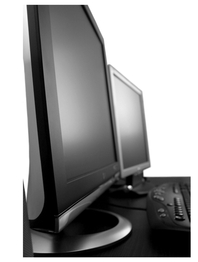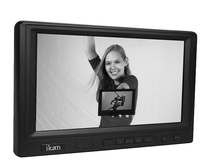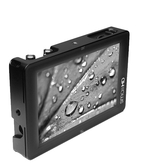13
Monitors
Marshal M. Rosenthal

Figure 13-1
From the studio to the field, to the editing suite, what to look for in a production monitor.
Editing video content was radically changed when digital technologies became a mainstay. Rather than physical manipulation, the content can now be manipulated at will in non-destructive ways, thanks to the video being stored digitally. The assortment of video-editing software programs range from extremely technical (for professionals), moderately complex (for prosumers) to extremely simple for the casual/ occasional video shooter. Regardless of the program’s level of sophistication, the single most important component, other than the computer, is the monitor the video is viewed on. The monitor is crucial for viewing your work and accessing the program’s editing functions, and also because the monitor’s physical characteristics and display settings can affect how the final video will look when presented.
The advent of the LCD monitor spelled the death of the CRT tube-based models. Beside the fact that flat-panels are lighter in weight and more energy-conservative, the size of the monitor is no longer the inhibiting factor it was with CRTs. Flat-panel monitors can also increase their size without substantially raising prices, thereby allowing for both higher resolutions and a physically greater viewing area. This works in tandem with computers to further the progress of HD as a common shooting and viewing option.
While a single monitor is part and parcel of today’s computing (all-in-one models like Apple’s iMacs and HP’s new Z1 workstation incorporate the technology and monitor together), having a second monitor is more than just a convenience when it comes to editing video. In fact, the addition of a third monitor is no longer viewed as an exotic option; computers designed to handle only one additional monitor are upgradable through an external device that works through a USB port to provide another monitor with “plug and play” capabilities. Additionally, there are tablet-sized LCD monitors, such as the AOC 16-inch Portable USB, that plug directly into a USB socket on the computer—obviating the need for any 120 V plug.
Watch the View
Computers offer two types of viewing systems when it comes to multiple displays: the first will see use for presentations or use with a projector, one monitor “mirrors” what is on the first (or main) monitor. For editing use, it’s the second type of viewing system that is used; i.e. to extend the working area (desktop) from one monitor to the next. In a video-editing setup, this allows menus and windows (whether they contain video or other information) to be placed apart from one another for both convenience and reducing clutter.
Computer monitors used for video editing must match the jack, and the graphic capabilities of the computer’s video card in order to function optimally. A monitor with a resolution able to display 1080p HD (1920 × 1080 pixels) will not receive the needed signal strength if the computer can’t provide this resolution. Similarly, if the computer only has a VGA output, having a DVI input on the monitor only will have to be worked around with an adapter in order to be successful. Fortunately, the majority of computers and laptops are able to display an HD image. The fact that high-resolution monitors have dropped in price is a welcome change.
Computer Monitor 101
VGA is an analog output that has been in use since the days of the CRT monitors, while DVI provides a digital signal. There are also newer standards, such as DisplayPort, which can be found on some monitors. Monitors typically provide controls for calibrating the image’s contrast, brightness, color temperature and other levels—in some cases the calibration is conducted automatically, while in other cases it must be initiated and done by hand. Regardless, it is worth noting that the individual taste of the person viewing the monitor will come into play; for example, a higher contrast being perfectly acceptable to one person while another would disagree.
The monitor’s aspect ratio is determined by its physical shape (either 4:3 or 16:9), and must be matched to the proper screen resolution put out by the computer’s graphic card. VGA, for example, can begin at a resolution of 640 × 480, but generally climbs higher, for example, into the realm of 800 × 600 (SVGA) or 1024 × 768 (XGA). For example, the PyleHome PLVW10IW is a 10.4-inch flat-panel (4:3 aspect ratio) reminiscent of a touch-screen tablet like the iPad. The LCD is wall-mountable (as is the case with most flat-panel monitors) and provides a resolution of 800 × 640 through a VGA input. An example of a widescreen (16:9) monitor with full 1080p resolution (1920 × 1080) is the 24-inch ViewSonic VA2431wm ($291). A DVI input provides for higher density of pixels on a screen with resolution of 1680 × 1050. This monitor features both VGA and DVI inputs and

Figure 13-2 Multiple input and throughput types can be essential if you need maximum adaptability in the field.
automatically adjusts for standard definition, (the built-in stereo speakers can be considered an added perk.)
Another example is the 7-inch SWIT S-1071 H (1024 × 600.) It features two HD/SD-SDI inputs, along with HDMI and component, and includes a video flip, Underscan/Overscan switch and 4:3 aspect ratio compatibility.
Computer versus Television
Those whose productions are headed for broadcast no doubt realize that the finished video should be viewed on an NTSC monitor that will accurately display the image as it is seen on conventional TVs. This is only reasonable since variations between what is seen on a computer monitor (whose pixels are square) and a TV (whose pixels are rectangular) can exist, both as subtle or not so subtle differences in the final image.
These types of NTSC monitors can vary in specifications and price but must all have the ability to display a video signal conforming to the TV standard. An example is the studio quality JVC’s 24-inch DT-R24L41DU LCD monitor ($3,200). Designed for use in post-production facilities as well as broadcast networks and TV stations, the HD image provides 1:1 monitoring with safe area markers compatible with different aspect ratios. The monitor has a wealth of inputs and, as expected, embedded technologies for metering the signal as it is viewed.
Those creating videos with less ambitious ends will still need to view how their finished work will look on a TV screen. Most computers can take the addition of a TV tuner card, which, besides providing TV-in capabilities, can output video for display on a conventional HDTV. There are also external video streaming devices (for example, the Warpia StreamHD VE) that only require a USB connection in order to sync with the computer and HDTV. Using a conventional HDTV to view the video before completion will add to the overall work time, but, there really is no other alternative if your viewing is confined to computers and mobile devices. The final video should be as compatible as possible with that of a televised signal in order to provide a consistent display of your final piece of video.
Production Monitors
Video broadcast monitors are useful for television production because they provide a realistic image that represents what is captured without any enhancements or alterations initially.
There are three different types of this kind of monitor; each is designed with different characteristics in order to perform various functions. The first is the “Grade 1” monitor, which provides a visual representation of the image without any masking of defects, such as in camera control and color grading. The second type of production monitor is “Grade 2.” This monitor comes with a wider tolerance for the image, and is often used in such situations as control rooms where no editing of the picture is necessary. The final type is the “Grade 3” monitor, which is the one most similar to high-end consumer displays. It is suitable for television production applications where durability and transportability of the unit is as important as its ability to handle such functions as audio production and dialogue dubbing. In addition, these types of production monitors are often used as displays in a studio with an in-house audience.
An example of a “Grade 3” monitor, useful for audio editing, is the Marshall OR-181 ORCHID ($3,000) Desktop Production Monitor. The monitor has an 18.5-inch LCD screen (widescreen, 1366 × 768 resolution), has a rack mount option and includes an assortment of production-based tools, for example, real-time waveform functions, an audio level meter and audio peak alarm. The OR-181 can display as many as 16 audio channels and has an audio channel loss functionality to warn against detected audio errors during monitoring.
Field Monitors and Camera-Mounted Monitors
Shooting on location or in the field is no different from in an indoor space when it comes to needing to view what is being recorded. There are two types of displays that can be used in conjunction with the camera: field monitors and camera-mounted monitors. A field monitor is designed for those on location (other than the camera operator) to see what is being shot, while a camera-mounted monitor “rides” the camera for use primarily by the camera operator. Screen sizes can be a bit more restrictive for camera-mounted monitors, while the division between these and field monitors is generally about seven inches.
Both types of monitors are used not only for simple viewing purposes, but also as an aid to ensure the best image with the least amount of difficulties when the finished work goes to post-production. They both feature industry-standard inputs for use with the commercial cameras available. Additionally, independent batteries often power both types of monitors, although conventional electrical outlets can be employed in some instances.
Prices for field monitors vary, depending on the screen size and features—as an example, the 7-inch LCD Marshall Electronics V-LCD70XP-HDIPT Field Monitor (800 × 480) comes in at $1,100. Besides loop-through capabilities for the HDMI, composite and component inputs (for enabling a second monitor to be connected), the monitor has a 600:1 contrast ratio and an adjustable backlight and DSLR ratio adjustment capabilities. Peaking filter/manual gamma adjustment and four user-configurable front-mounted buttons are also included.
At $900, the ikan VX9e provides a 8.9-inch LCD screen with such features as full color/monochrome, peaking and moveable pixel-to-pixel, and an adjustable threshold clip guide. Inputs for the field monitor’s 1024 × 800 resolution (300:1 contrast ratio) can be had through HD-SDI (analog component conversion) as well as HDMI, component and S-Video/composite.
On-camera monitors can also come in an “eyepiece” configuration for viewing directly, for example the Cineroid EVF4Le ($700), which also has a HDMI



Figure 13-3, 13-4, and 13-5 Don’t’ let their small size fool you. Sure, most field and camcorder-mounted monitors can be stashed in the side pocket of even a small camera case but most also have very sophisticated display features.
loop-through feature. Diopter focus adjustments and other controls are mounted on the unit as well. An example is the Marshall Electronics 5-inch V-LCD50-HDI monitor, which comes with a sun hood. Other useful features are a shoe-mount adapter, HDMI input and front panel controls for brightness, color, contrast and the like. A false color view aids in maintaining a consistent image of what is being seen on the monitor, which has a pixel resolution of 800 × 480 and a contrast ratio of 600:1. Should you wish to switch from a monitor to EVF easily, the SmallHD DP4 EVF gives you the best of both worlds: a standalone 4:3 monitor that converts into an electronic viewfinder ($600). The 16.7 million color LED backlit LCD panel is ruggedly constructed and includes frame guides that work with DSLR signals as well as video, focus assist and peaking filters and moveable 1:1 pixel mapping.
You can’t edit what you can’t see, and field, desktop and production monitors have played a major role in taking video creation into the modern age. Like any electronic device, they are not a substitute for making choices as to how to edit, but they will let you see the results of those choices you’ve made.
